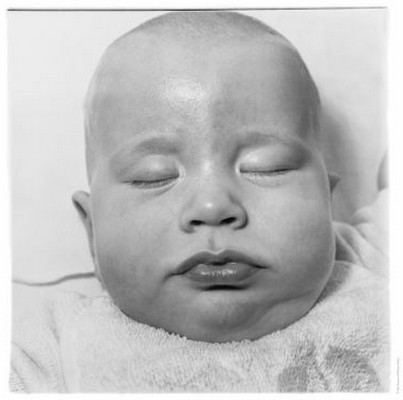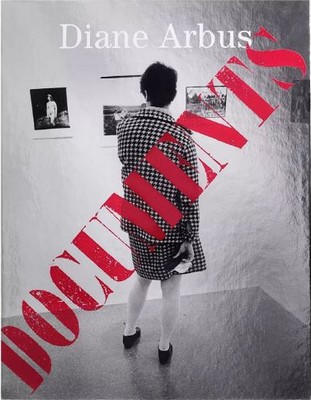Cataclysm: The 1972 Diane Arbus Retrospective Revisited
David Zwirner, New York
September 14 — October 22, 2022
A very young baby, N.Y.C. [Anderson Hays Cooper], 1968
© The Estate of Diane Arbus, courtesy David Zwirner
David Zwirner and Fraenkel Gallery presents Cataclysm: The 1972 Diane Arbus Retrospective Revisited, on view at David Zwirner’s 537 West 20th Street location in New York. Organized by both galleries to commemorate the fiftieth anniversary of the artist’s momentous 1972 posthumous retrospective at The Museum of Modern Art, New York, Cataclysm re-creates the iconic exhibition’s checklist of 113 photographs, underscoring the subversive poignancy of Arbus’s work even today while highlighting the popular and critical upheaval the original exhibition precipitated.
In the fall of 1971, in the aftermath of Arbus’s death in July, her friend, colleague, and fellow artist Marvin Israel approached John Szarkowski, the legendary director of photography at The Museum of Modern Art, about the prospect of a retrospective exhibition of her work. Szarkowski, who had begun championing Arbus’s photographs in the late 1960s, quickly agreed to do the show. Though widely admired and respected by other photographers and artists, Arbus was not well known at the time of her death. When the exhibition opened, on November 7, 1972, no one, not even Arbus’s most fervent supporters, could have predicted its profound impact on museum visitors, nor the impassioned—at times vitriolic—critical response the exhibition would generate among writers and thinkers. It was the most highly attended one-person exhibition in the museum’s history, with lines down the block to see it. Szarkowski later recalled, “People went through that exhibition as though they were in line for communion.”1
Even at the time, the retrospective was recognized for almost single-handedly helping to elevate photography to the status of fine art, paving the way for museums, collectors, and the public to embrace a previously unrecognized innate authority and power within the medium. As the New York Times critic Hilton Kramer wrote of the exhibition, “what Diane Arbus brought to photography was an ambition to deal with the kind of experience that had long been the province of the fictional arts—the novel, painting, poetry and films—but had traditionally been ‘off limits’ to the nonfiction documentary art of the still camera.”2 John Perreault, writing in The Village Voice, noted, “I don’t usually write about photography … but just this once I can’t resist. Diane Arbus was such a great photographer that her work breaks out of all categories. Her retrospective at the Museum of Modern Art should be of interest even to those who are not usually at all interested in photography.”3
Such praise from some critics was countered with derision and ridicule by others. Susan Sontag disparaged the exhibition in the pages of The New York Review of Books: “Arbus’s work shows people who are pathetic, pitiable, as well as horrible, repulsive, but it does not arouse any compassionate feelings.”4 Jane Allen, writing for the Chicago Tribune, attacked the show: “[Arbus] shows us people, so locked into their physical and mental limitations, that their movements are meaningless charades. They are losers almost to a man.”5 What seems to have enthralled some and enraged others about Arbus’s work was how she unflinchingly captured the singularity of her subjects, which—paradoxically—linked them to one another and by extension to the viewer. “This is what I love,” wrote Arbus at the age of sixteen, “the differentness, the uniqueness of all things and the importance of life.… I see the divineness in ordinary things.”6
The exhibition’s title, Cataclysm, alludes to the immensity of the uproar spawned by the retrospective and the ferocity of the critical discourse around the artist that emerged then and continues to the present day.
1 Quoted in Who Is Marvin Israel?, directed by Neil Selkirk and Doon Arbus (2005; www.neilselkirk.com/films).
2 Hilton Kramer, “From Fashion to Freaks,” The New York Times Magazine, November 5, 1972, p. 38.
3 John Perreault, “Art,” The Village Voice, November 23, 1972, p. 40.
4 Susan Sontag, “Freak Show,” The New York Review of Books, November 15, 1973, p. 14.
5 Jane Allen, “Charade of Losers in the Arbus World,” Chicago Tribune, April 8, 1973, p. 8.
6 Diane Arbus, high school essay on Plato, 1939. Quoted in Diane Arbus Revelations (New York: Random House, 2003), p. 70.
David Zwirner Books/Fraenkel Gallery, September 2022
Hardcover, with exposed spine, 8.5 × 11 in | 21.6 × 27.9 cm
496 pages, 69 texts in facsimile
Texts by 55 authors, including Hilton Als, A. D. Coleman, Holland Cotter, Jacob Deschin, Germaine Greer, Hilton Kramer, Arthur Lubow, Janet Malcolm, Francine Prose, Sukhdev Sandhu, Peter Schjeldahl, Adrian Searle, Susan Sontag, Lynne Tillman, and Colm TóibínForeword by Jeffrey Fraenkel and Lucas ZwirnerEdited by Max RosenbergCataclysm: The 1972 Diane Arbus Retrospective Revisited coincides with the release of Diane Arbus Documents. Through an assemblage of articles, criticism, and essays from 1967 to the present, this groundbreaking publication charts the reception of the photographer’s work and offers comprehensive insight into the critical conversations, as well as misconceptions, around this highly influential artist.Best known for her penetrating images exploring what it means to be human, Diane Arbus is a pivotal and singular figure in American postwar photography. Arbus’s black-and-white photographs demolish aesthetic conventions and upend all certainties. Both lauded and criticized for her photographs of people deemed “outsiders,” Arbus continues to be a lightning rod for a wide range of opinions surrounding her subject matter and approach. Critics and writers have described her work as “sinister” and “appalling” as well as “revelatory,” “sincere,” and “compassionate.”Illuminating more than five decades in the evolution of art criticism, Documents provides a new template for understanding the work of any formidable artist. Organized in eleven sections that focus on major exhibitions and significant events emerging from Diane Arbus’s work, as well as on her methods and intentions, the sixty-nine facsimiles of previously published articles and essays––an archive by any measure––trace the discourse on Diane Arbus, contextualizing her inimitable oeuvre. Supplemented by an annotated bibliography of more than six hundred entries and a comprehensive exhibition history, Documents serves as an important resource for photographers, researchers, art historians, and art critics, in addition to students of art criticism and the interested reader alike.
Aperture, September 2022
Clothbound with jacket, 9 5/8 × 12 1/2 inches | 24.4 × 32.4 cm
352 pages, 200 duotone and 300 four-color and black-and-white images
Photographs by Diane ArbusTexts by Doon Arbus, Sarah H. Meister, Sandra S. Phillips, Jeff L. Rosenheim, Neil Selkirk, and Elisabeth Sussman
A richly illustrated chronology serves as the narrative core of Diane Arbus: Revelations, exploring the origins, scope, and aspirations of this wholly original force in photography. Arbus’s frank treatment of her subjects and her faith in the intrinsic power of the medium have produced a body of work that is often shocking in its purity, in its steadfast celebration of things as they are. In addition to the incisive texts and extensive research, Revelations reproduces two hundred full-page duotones of Diane Arbus photographs spanning her entire career.
DAVID ZWIRNER
537 West 20th Street, New York, NY 10011
Related Posts on Wanafoto



